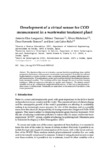Development of a Virtual Sensor for COD Measurement in a Wastewater Treatment Plant

Use this link to cite
http://hdl.handle.net/2183/34120
Except where otherwise noted, this item's license is described as Attribution 4.0 International (CC BY 4.0)
Metadata
Show full item recordTitle
Development of a Virtual Sensor for COD Measurement in a Wastewater Treatment PlantAuthor(s)
Date
2023Abstract
[Abstract] The objective of the work is to develop a system that allows predicting, from a global
perspective, the behavior of the process in a wastewater treatment plant. To do this, the chemical
oxygen demand, a variable present in water, is estimated indirectly, avoiding difficult and
complex measurements. This estimation is carried out in real time through the relationship between
easily measured variables. This modeling will be done through the use of machine learning
techniques. Different regression techniques are applied and compared. The dataset contains
variables such as pH, conductivity, suspended solids and etc. In thisway, a non-physical indirect
sensor is implemented. Thresholds are established for the detection of deviations in the sensor
parameters
Keywords
Aprendizaje automático
Conjunto de datos
Aguas residuales
Conjunto de datos
Aguas residuales
Description
Cursos e Congresos , C-155
Editor version
Rights
Attribution 4.0 International (CC BY 4.0)






